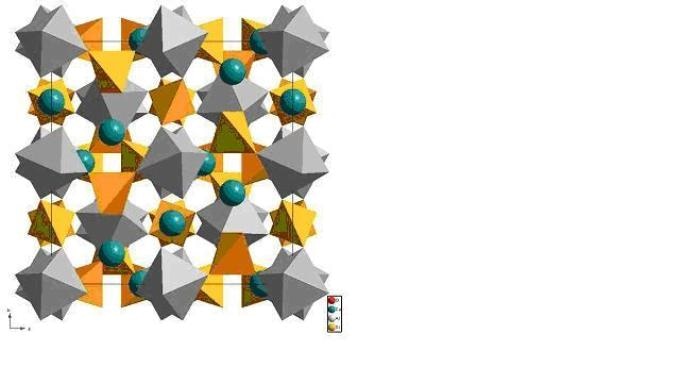Jun 21 2018
A group of researchers from the Lobachevsky University of Nizhny Novgorod (UNN) - including physicists, chemists, and engineers - has at present made joint research attempts to overcome the challenges faced in handling plutonium and minor actinides (MA) piled up over several years. To achieve this, they have been analyzing composite ceramics-metal (CerMet) and ceramics-ceramics (Cer-Cer) materials based on mineral-like compounds (specifically garnet minerals). The researchers are confident that the ideal solution to the problem would be to develop high-density ceramic composite inert fuel matrices (IMF) for incinerating plutonium and converting minor actinides.
 The crystal structure of yttrium-aluminum garnet. (Image credit: Lobachevsky University)
The crystal structure of yttrium-aluminum garnet. (Image credit: Lobachevsky University)
According to Ludmila Golovkina, Head of the UNN Solid State Chemistry Laboratory, with all their benefits with respect to applications in nuclear power engineering, mineral-like garnet-based ceramics have some disadvantages, such as their low fracture toughness and low thermal conductivity. The former disadvantage leads to microfracturing, which develops open surfaces and decreases chemical (hydrolytic) stability of ceramics. The latter disadvantage could result in an additional increase in temperature from radiogenic heat that leads to lower chemical stability.
In this regard, the idea of creating ‘ceramics-ceramics’ and ‘ceramics-metal’ composites seems very promising. With the right choice of components in such a material, the second phase (ceramic or metallic) could provide both an increase in thermal conductivity and an increase in fracture toughness.
Ludmila Golovkina
Within the context of the Russian Science Foundation grant No.16-13-10464 “Promising ceramic mineral-like materials with improved and adjustable service characteristics: development, synthesis, study,” a group of scientists led by Dr Albina Orlova, professor of the Department of Solid State Chemistry and lead researcher of the UNN Physics and Technology Research Institute, has synthesized and analyzed fine-grained composites based on Y2.5Nd0.5Al5O12 garnet with additives such as highly heat-conductive metals (for example, tungsten, molybdenum, and nickel) and silicon carbide with a low neutron capture cross-section. They mimicked the presence of curium and americium in the ceramic composition by using neodymium that was incorporated in the yttrium-aluminum garnet.
Professor Albina Orlova stated that an innovative chemical and metallurgical technique was developed and used for depositing thin metal layers on the surface of produced submicron garnet particles. On the other hand, high-speed spark plasma sintering was adopted for sintering the powdered materials and to synthesize the ceramics. It is a propitious technique for synthesizing ceramics and composites, which involves heating powders at a high rate, passing high-power (up to 5000 A) millisecond DC pulses, and concurrently applying the needed pressure.
Lobachevsky University scientists have studied in detail the features of high-speed multistage sintering of such composites. It was shown that the process of sintering composites consists of two stages: at the first stage, the densification process is associated with the plastic flow of the material, and at the second stage, it occurs due to the diffusion in the garnet crystal lattice.
Albina Orlova
The study by Professor Orlova’s team allowed the production of “garnet-metal” and “garnet-silicon carbide” ceramic compositions with a high relative density (92%–99% of the theoretical value for “garnet-metal” and 98%–99% for “garnet-SiC” composites).
Thus, we can ensure high hardness and fracture toughness of composites, as well as their high thermophysical properties, in particular, thermal conductivity in the temperature range close to the temperatures that these materials will experience when used in new fast neutron reactors. All other things being equal, this will reduce the probability and intensity of destruction of the ceramics in the process of reactor operation.
Albina Orlova
The outcomes of the studies have been reported in the journals Materials Research Bulletin (2018, v.103, p. 211–215) and Materials Chemistry and Physics (2018, v. 214, p. 516–526).
The subsequent stage in this study will be the analysis of the radiation stability of the new composites as well as their resistance to thermal shock. As a result, the researchers will get even closer to devising a fundamentally innovative technique for producing fuel for fast neutron reactors and to overcoming the challenge of immobilization of highly radioactive waste components by securely isolating them from the biosphere.